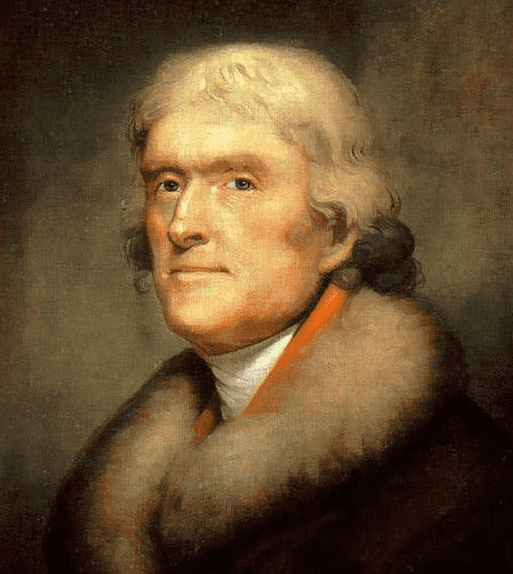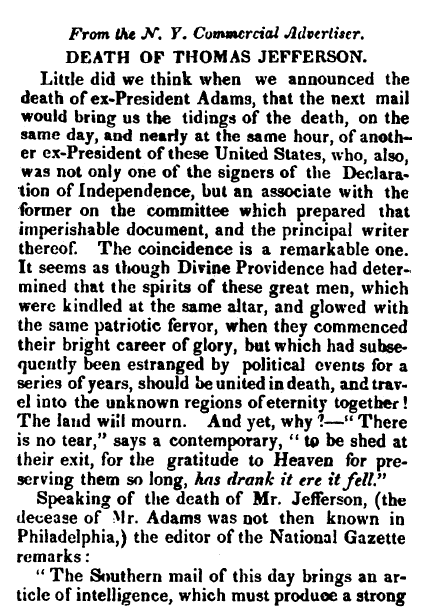Introduction: Duncan Kuehn is a professional genealogist with over eight years of client experience. She has worked on several well-known projects, such as “Who Do You Think You Are?” and researching President Barack Obama’s ancestry. In this blog post, Duncan searches old newspapers to learn more about the remarkable coincidence of John Adams and Thomas Jefferson – friends and ex-presidents – both dying on 4 July 1826, the nation’s 50th anniversary.
John Adams, the nation’s 2nd president, and Thomas Jefferson, the 3rd president, were a large presence in one another’s life – a lifelong personal connection that continued to the day they both died: 4 July 1826, the 50th anniversary of the young country they were instrumental in creating and leading.

John Adams (1735-1826) and Thomas Jefferson (1743-1826), were friends and companions as they fought for independence from the British government. Although Jefferson was ultimately the author of the Declaration of Independence, Adams was initially favored to draft it and was on the writing committee – from which position he convinced the other members that Jefferson was the right man for the job. After the Declaration was written, Adams was perhaps the loudest and most assertive of its supporters and was hailed as a champion to the cause – which only increased the goodwill between the two men.

Their individual personalities and political opinions about how the new government should function, however, proved to be radically different. John Adams was aggressively in favor of a strong federal government and his bold, pushy demeanor alienated many. Thomas Jefferson was refined and gentile. He strongly defended the rights of the individual states over the rights of the federal government. The two men clashed constantly on political issues.
Both ran for the office of president of the United States after George Washington. Adams won the office in 1796 with the most votes and, as was customary at the time, Jefferson was made vice-president after receiving the second-highest number of votes. It was a political role Jefferson despised. He ended up beating Adams for the presidential office in the 1800 election and set to work undoing as much of Adams’s work as he could. He called it the “Revolution of 1800.”
In their latter years, they were able to set aside their differences and repair the relationship, maintaining a strong, steady correspondence for the last 14 years of their lives. On 4 July 1826, the 50th anniversary of the signing of the Declaration of Independence, they both lay in their sick beds. Jefferson died first, but Adams didn’t know that when he said his last words: “Jefferson survives.” Adams, being older, was one of the longest-living presidents. He died just months shy of his 91st birthday. Of the signers of the Declaration of Independence, only Charles Carroll was still living after Adams and Jefferson died.
[search_box]
In the midst of celebrating the nation’s 50th anniversary, Americans marveled that these two great leaders and friends died together on such an important day – the only time in U.S. history two presidents have died on the same day.
As the following newspaper obituary noted:
The coincidence is a remarkable one. It seems as though Divine Providence had determined that the spirits of these great men…should be united in death, and travel into the unknown regions of eternity together!

The importance of the 4th of July was also emphasized in this obituary.

Obituaries – of ordinary citizens as well as famous people – help provide the details of our ancestors’ lives. GenealogyBank’s deep newspaper archive of over 1.7 billion records holds story after story about the people who built this nation, along with their births, marriages, and deaths. Find your ancestors’ stories today and see what they’ve done.
Note: FamilySearch International (FamilySearch.org) and GenealogyBank are partnering to make over a billion records from historical obituaries searchable online. The tremendous undertaking will make a billion records from over 100 million U.S. newspaper obituaries readily searchable online. The newspapers are from all 50 states and cover the period 1730 to the present. Find out more at: https://www.genealogybank.com/family-search/
Related Articles:
- What Were the Real Last Words of These U.S. Presidents?
- Fourth of July Trivia: Quiz Your History IQ
- History of Fireworks in America: News from 1700s Forward
[bottom_post_ad]
